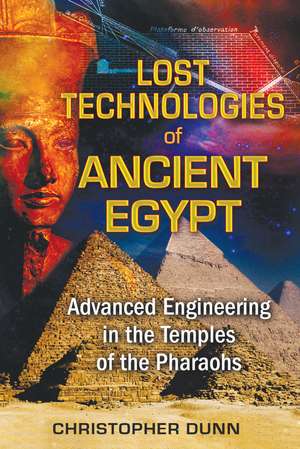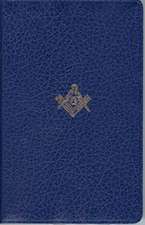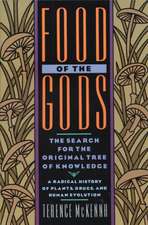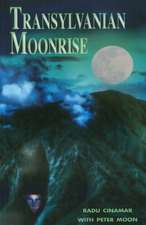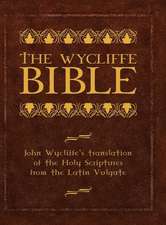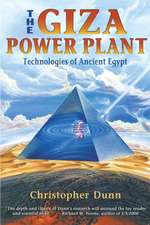Lost Technologies of Ancient Egypt: Advanced Engineering in the Temples of the Pharaohs
Autor Christopher Dunnen Limba Engleză Paperback – 23 iun 2010
Preț: 147.68 lei
Nou
28.26€ • 30.22$ • 23.56£
Carte disponibilă
Livrare economică 27 martie-10 aprilie
Specificații
ISBN-10: 1591431026
Pagini: 400
Ilustrații: 43 color and 280 b&w illustrations
Dimensiuni: 152 x 229 x 25 mm
Greutate: 0.64 kg
Editura: Inner Traditions/Bear & Company
Colecția Bear & Company
Notă biografică
Christopher Dunn is a manufacturing engineer with 50 years of experience. He has worked primarily in aerospace with an emphasis on precision and laser application. He has published a dozen articles on his theories about ancient technology and is the author of The Giza Power Plant. He lives in Illinois.
Extras
SHADOWS OF THE SERAPEUM
Before visiting the temples in Upper Egypt, I descended into the shadows of what must be the most confounding and enigmatic archaeological site in the world--the Serapeum. The site has little left above ground to identify it except a gaffirs’ hut and low walls on both sides of an inclined path that lead to formidable dungeonlike iron doors. Attached to the iron bars that form a transom above the doors there is a sign in Arabic and English that reads:
SERAPEUM DYN XVIII PTOLEMY XII C.1405–30 B.C.E
Though dark and dusty, the Serapeum was a welcome relief from the heat. Shadows were thrown at intervals along the numerous tunnels by incandescent bulbs, and alcoves or crypts cut at right angles on each side of the tunnel made the place even more mysterious. Both the tunnels and the crypts had barrel-shaped, vaulted ceilings that had suffered damage over the millennia with places where large pieces of limestone had separated from the bedrock and fallen. Some areas had wooden frames with thick plywood sheets on top for protection. A fine dust kicked up from the floor hung in the air.
In the center of each crypt was placed a large granite box with a lid on top. All of the boxes were finished on the inside and the bottom side of the lid, but not all were finished on the outside. It appears that work stopped suddenly in the Serapeum, for there were boxes in several stages of completion: boxes with lids, boxes that yet had to have the lid placed on them, and a rough box and lid near the entrance.
The historical explanation for the boxes in the Serapeum is that they were funerary sarcophagi used to hold the carcass of the sacred Apis Bulleven. The Apis Bull was considered to be a god by the ancient Egyptians, and the Serapeum was reputed to house the burial vaults of the Apis cult. Bull heads were found in niches in the tunnels, and a statue of a bull was retrieved from the tunnels and now sits in the Louvre Museum in Paris.
The ancient Egyptians worshipped the Apis as a god, and a search was made throughout the land for a replacement of a bull that died or was about to be sacrificed. When an Apis died, there was mourning throughout the land and a self-imposed celibacy. Until another Apis with the specific markings was found, there was no sex. To say that the mourners were motivated to find one, and in a hurry, would be an understatement. Once found, the new god incarnate was installed with celebration and joy, in that continuity of the Apis god among the Egyptians was assured and signifying that the heavens were pleased and the land and its people would be protected and flourish.
One of the crypts has a granite box that has a corner broken out of it and is accessible by means of steps down to the lower floor. The outside of the box appeared to be roughly finished, but the glint of a high polish on the inside surfaces beckoned me to climb inside. Running my hand along the surface of the granite reminded me of the thousands of times I have run my hand along a granite surface plate when I was working as a machinist and later as a tool and die maker. The feel of the stone was no different, though I was not sure of its flatness, or precision. To check my impression I placed the edge of my precision-ground parallel against the surface--and saw that it was dead flat. There was no light showing through the interface of the steel and the stone, as there would be if the surface was concave, and there was no rocking back and forth along the length of the steel, as there would be if the surface was convex. To put it mildly, I was astounded. I did not expect to find such precision, because this order of precision is not necessary for the sarcophagus of a bull, or any other animal or human.
I slid the parallel along the surface both horizontally and vertically, and there was no deviation from a true flat surface, similar to precision-ground surface plates used in manufacturing to verify precisely machined parts that require extremely accurate surfaces and dimensions. Those familiar with the relationship between gauges and surface plates understand that the accuracy of the reading is constrained to the length of the gauge with which the comparative check is made. In other words, the gauge may show that the stone is flat within the tolerance of the gauge--in this case .0002 inch (.00508 mm) flatness. However, if the gauge is moved six inches along the stone surface and the same conditions are found, it cannot be claimed with certainty that the stone is within the same tolerance over the full 12 inches--unless the plate has been inspected by another means and is calibrated to a known standard. In light of this, I determined that a longer straightedge was needed and, preferably, even more sophisticated alignment equipment before I could come to any further conclusions.
Returning to the hotel that evening, my mind was consumed by what I had seen. These artifacts were precision-crafted boxes on a very large scale. It just didn’t make sense to think that the ancient Egyptians would pour such resources into manufacturing a coffin while the mausoleum where the God Apis rested was rough cut and undecorated. Once the lid was on top of the box, nobody would see the perfectly flat and polished surfaces or the conformity to orthogonal precision.
But I am not thinking like an Egyptian or an Egyptologist. I am thinking like an engineer, and the challenges that these boxes would present to an engineer with modern stone-working tools are significant.
Cuprins
Foreword: Shifting Paradigms by Arlan Andrews Sr., ScD
Foreword: Recognizing the Brilliance of Ancient Manufacturing by Judd C. Peck, Esq.
Photographic Credits
Acknowledgments
Introduction
One The Shadows of Luxor
Two The Shadows of Ramses
Three The Ramses Challenge
Four The Shadows of Karnak
Five The Shadows of the Serapeum
Six The Shadow of the Sphinx
Seven The Shadows of Denderah
Eight Sticks and Stones: Tools of the Trade
Nine In the Shadow of an Obelisk
Ten In the Shadow of Egyptian Megamachines
Eleven Walking in the Shadow of William F. Petrie
Twelve Suspending Disbelief
Notes
Selected Bibliography
Index
Recenzii
“This is an extremely important and original book. Christopher Dunn indisputably demonstrates that the ancient Egyptians were much more technologically advanced than the vast majority of modern Egyptologists, archaeologists, and historians ever dared imagine.”
“Christopher Dunn makes a stunningly convincing case that the makers of the ancient Egyptian stone monuments and images possessed sophisticated technologies rivaling our own in terms of their precision and capabilities.”
“Christopher Dunn is an expert in his field. He knows a great deal about stone-cutting tools and has spent many years studying the ancient Egyptian monuments, sculptures, and artifacts. His findings are revolutionary. His word carries weight. If he is right, our perception of who the ancient Egyptians were may completely change. Read this book!”
“Christopher Dunn’s painstaking work, literally, makes the ‘stones’ of the Egyptian gods speak. He provides profound archaeological evidence that shows an engineering consistency, suggesting an advanced intelligence, which understood the supreme science of sacred geometry. A must-read book for those who wish to understand the advancement of Egyptology in the world of today.”
“Utilizing almost 50 years of professional experience in engineering, manufacturing, tool-making, and space-age precision, Chris Dunn has provided an in-depth analysis of ancient Egyptian statuary, temples, and manufactured artifacts that has never been presented previously. This outstanding book, supremely well researched, amply illustrated, and complete with detailed photographs, will be cited as a major paradigm shift and reference source in the field for many years to come.”
“Admirers of Egyptian art and architecture are most fortunate that Christopher Dunn directs his experienced engineer’s eye toward the Egyptians’ ancient stonework. By noticing the most minute details he reveals sophisticated craftsmanship and immense significance for all areas of Egyptology. Mathematicians will appreciate the amazing three-dimensional geometry made manifest in very hard stone. Dunn points the way for geometers to uncover sharper, more accurate analyses of the proportions of Egyptian design. This book is an important contribution to scientific scholarship by showing how archaeology can firmly rest on a measurable foundation.”
“In this book, Christopher Dunn has brought to the field of Egyptology a new approach, which has been needed for decades. His ability as an engineer and master craftsman has given him the insight to discover ancient technologies and techniques that have been missed by traditional Egyptologists. This book is a paradigm change for the way of thinking about our ancient history and ancestors. I highly recommend this beautiful illustrated book to both academic and alternative researchers and for anyone interested in new ways of thinking about our ancient past.”
“As with Newton and the apple, Chris Dunn got a vision when visiting Egypt. His engineering background allowed him to unleash incredible facts, and thanks to this highly detailed book, we can now share the same marvels.”
“If you want to see the precise high technologies ancient Egyptians really had, read this book. It is a serious donation to Egyptian legacy and an opus for the future of this planet.”
“I believe, as Chris Dunn superbly details in this book, that ancient Egyptian sculptors and architects were so precise and their works so monumental that they must have used sophisticated technology, probably hidden in their time and now lost to ours.”
“. . . Chris Dunn, with over 20 years of investigation, possessing unique technical skills, and showing a keen, perceptive eye for detail, has unlocked the door to knowledge that will eventually overturn established thinking about the civilization we call ‘Ancient Egypt’.”
Descriere
From the pyramids in the north to the temples in the south, ancient artisans left their marks all over Egypt, unique marks that reveal craftsmanship we would be hard pressed to duplicate today. Drawing together the results of more than 30 years of research and nine field study journeys to Egypt, Christopher Dunn presents a stunning stone-by-stone analysis of key Egyptian monuments, including the statue of Ramses II at Luxor and the fallen crowns that lay at its feet. His modern-day engineering expertise provides a unique view into the sophisticated technology used to create these famous monuments in prehistoric times. Using modern digital photography, computer-aided design software, and metrology instruments, Dunn exposes the extreme precision of these monuments and the type of advanced manufacturing expertise necessary to produce them. His computer analysis of the statues of Ramses II reveals that the left and right sides of the faces are precise mirror images of each other, and his examination of the mysterious underground tunnels of the Serapeum illuminates the finest examples of precision engineering on the planet. Providing never-before-seen evidence in the form of more than 280 photographs, Dunn’s research shows that while absent from the archaeological record, highly refined tools, techniques, and even mega-machines must have been used in ancient Egypt.
